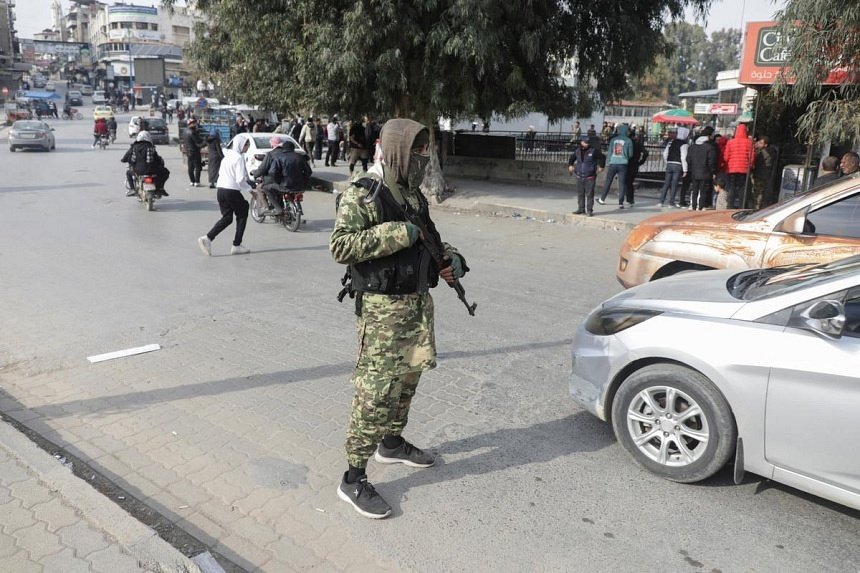Updated
Dec 07, 2024, 10:44 PM
Published
Dec 07, 2024, 10:21 AM
AMMAN/BEIRUT – Syrian rebels pressed their lightning advance on Dec 7, saying they had seized most of the south, as government forces dug in to defend the key central city of Homs to try to save President Bashar al-Assad’s 24-year rule.
Since the rebels’ swept into Aleppo on Nov 29, government defences have crumbled across the country at dizzying speed as the insurgents seized a string of major cities and rose up in places where the rebellion had long seemed over.
Besides capturing Aleppo in the north, Hama in the centre and Deir al-Zor in the east, rebels said they have taken southern Quneitra, Deraa and Suweida and advanced to within 50km of the capital Damascus.
Government defences were focused on Homs, with state television and Syrian military sources reporting massive air strikes on rebel positions and a wave of reinforcements arriving to dig in around the city.
Meanwhile, the rebels extended their control to almost the entire south-west and said they had captured Sanamayn on the main highway from Damascus to Jordan. The Syrian military said it was repositioning, without acknowledging territorial losses.
The pace of events has stunned Arab capitals and raised fears of a fresh wave of regional instability, with Qatar saying on Dec 7 that this threatened Syria’s territorial integrity.
Syria’s civil war, which erupted in 2011 as an uprising against Mr Assad’s rule, dragged in big outside powers, created space for militants to plot attacks around the world and sent millions of refugees into neighbouring states.
Western officials say the Syrian military is in a difficult situation, unable to halt rebel gains and forced into retreat.
Mr Assad had long relied on allies to subdue the rebels, with Russian warplanes bombing from the skies while Iran sent allied forces including Lebanon’s Hezbollah and Iraqi militia to bolster the Syrian military and storm insurgent strongholds.
But Russia has been focused on the war in Ukraine since 2022 and Hezbollah has suffered big losses in its own gruelling war with Israel, significantly limiting its ability or that of Iran to bolster Mr Assad.
Russia on Dec 6 urged its nationals to leave the country. Iran evacuated families of diplomats from Syria, an Iranian official said.
Hezbollah sent some “supervising forces” to Homs on Dec 6, but any significant deployment would risk exposure to Israeli air strikes, Western officials said. Israel attacked two Lebanon-Syria border crossings on Dec 6, Lebanon said.
Iran-backed Iraqi militia are on high alert, with thousands of heavily armed fighters ready to deploy to Syria, many of them amassed near the border. But they have not yet been ordered to cross, two of their commanders said. Iraq does not seek military intervention in Syria, a government spokesman said on Dec 6.
Iran, Russia and Turkey, which is the main foreign supporter of the rebels, will meet on Dec 7 to discuss the crisis in Syria.
Iranian Foreign Minister Abbas Araqchi told Iranian television that “no specific decisions have been made regarding a horizon for Syria’s future”. He said his meetings in Doha were focused on preserving Syria’s territorial integrity and preventing “potential consequences” in the region.
Battle for Homs
The rebels said they were “at the walls” of Homs after taking the last village on its northern outskirts late on Dec 6.
Inside Homs, a resident said the situation had felt normal until that day, but had grown more tense with the sound of air strikes and gunfire clearly audible and pro-Assad militia groups setting up checkpoints.
“They are sending a message to people to keep in line and that they should not get excited and not expect Homs to go easily,” the resident said.
Seizing Homs, a key crossroads between the capital and the Mediterranean, would cut off Damascus from the coastal stronghold of Mr Assad’s minority Alawite sect, and from a naval base and airbase of his Russian allies there.
A Syrian military officer said there was a lull in fighting on the morning of Dec 7 after a night of intense air strikes on the rebels and that a large convoy of troops and vehicles had been redeployed from Palmyra to aid the Homs defence.
A coalition of rebel factions that include Islamist group Hayat Tahrir al-Sham (HTS) made a last call on forces loyal to Mr Assad’s government in Homs to defect.
Ahead of the rebel advance, thousands of people fled Homs towards the coastal regions of Latakia and Tartus, strongholds of the government, residents and witnesses said.
“Homs is the key. It will be very hard for Assad to make a stand, but if Homs should fall, the main highway from Damascus to Tartus and the coast will be closed, cutting the capital off from the Alawite Mountains,” said Syria specialist Jonathan Landis of the University of Oklahoma. “The Syrian army won’t fight. No one wants to die for Assad and his regime,” he added.
In the south, the fall of Deraa and Suweida on Dec 6, followed by Quneitra on Dec 7, could allow a concerted assault on the capital, the seat of Mr Assad’s power, military sources said. The Syrian military pulled back to a more defensible position in Saasa, the Syrian military officer said.
Deraa, which had a population of more than 100,000 before the civil war began 13 years ago, holds symbolic importance as the cradle of the uprising. It is the capital of a province of about one million people, bordering Jordan.
In the east, a US-backed alliance led by Syrian Kurdish fighters captured Deir el-Zor, the government’s main foothold in the vast desert, on Dec 6, three Syrian sources told Reuters, jeopardising Mr Assad’s land connection to allies in Iraq. REUTERS
